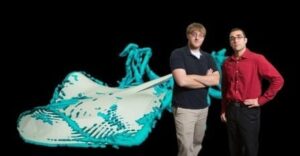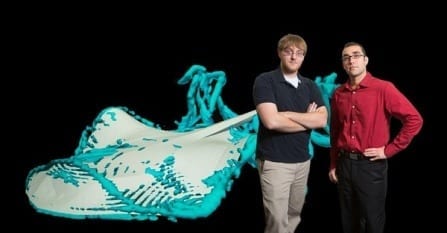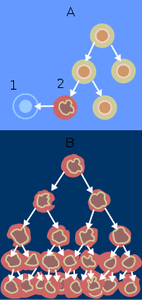
The fish’s unique way of swimming could improve deep-sea vehicles’ agility and fuel efficiency
Stingrays swim through water with such ease that researchers from the University at Buffalo and Harvard University are studying how their movements could be used to design more agile and fuel-efficient unmanned underwater vehicles.
The vehicles could allow researchers to more efficiently study the mostly unexplored ocean depths, and they could also serve during clean up or rescue efforts.
“Most fish wag their tails to swim. A stingray’s swimming is much more unique, like a flag in the wind,” says Richard Bottom, a UB mechanical engineering graduate student participating in the research.
Bottom and Iman Borazjani, UB assistant professor of mechanical and aerospace engineering, set out to investigate the form-function relationship of the stingray — why it looks the way it does and what it gets from moving the way it does.
They will explain their findings at the 66th Annual Meeting of the American Physical Society Division of Fluid Dynamics. Their lecture, “Biofluids: Locomotion III – Flying,” is at 4:45 p.m. on Sunday, Nov. 24, in Pittsburgh, Pa.
The researchers used computational fluid dynamics, which employs algorithms to solve problems that involve fluid flows, to map the flow of water and the vortices around live stingrays.
The study is believed to be the first time the leading-edge vortex, the vortex at the front of an object in motion, has been studied in underwater locomotion, says Borazjani. The leading-edge vortex has been observed in the flight of birds and insects, and is one of the most important thrust enhancement mechanics in insect flight.
The vortices on the waves of the stingrays’ bodies cause favorable pressure fields — low pressure on the front and high pressure on the back — which push the ray forward. Because movement through air and water are similar, understanding vortices are critical.
“By looking at nature, we can learn from it and come up with new designs for cars, planes and submarines,” says Borazjani. “But we’re not just mimicking nature. We want to understand the underlying physics for future use in engineering or central designs.”
Studies have already proven that stingray motion closely resembles the most optimal swimming gait, says Bottom. Much of this is due to the stingray’s unique flat and round shape, which allows them to easily glide through water.
Go deeper with Bing News on:
Underwater locomotion
- Penguin-inspired robot explores sea using AI
Quadroin AUV is an underwater research robot that mimics penguins' graceful and swift swimming, descending to depths of 492 feet at speeds up to 11.5 mph.
- Penguin-inspired robot explores the sea using AI
The Quadroin AUV, inspired by penguin locomotion, is a state-of-the-art underwater robot designed for oceanic exploration and data collection.
- This Remotely-Controlled Robot Can Revolutionize Underwater Missions With 'Fin-Tastic' Features
With HERO-BLUE now at the center of underwater discoveries, this not-so-common robot will impress you with its unique set of skills from the get-go.
- The shape-shifting underwater robot pioneering the depths of the sea
HERO-BLUE is a proof-of-concept robot, measuring 31.5 inches by 23.6 inches by 11.8 inches and weighing 24.9 pounds. It’s remotely controlled, but with its stereoscopic vision, the future could see ...
- Robot penguins: This underwater drone can cruise at 11.5 mph
German underwater robotics company EvoLogics has ... qualities of the AUV are the result of years of research on penguin locomotion by the team. The Quadroin’s low drag form allows it to reach ...
Go deeper with Google Headlines on:
Underwater locomotion
[google_news title=”” keyword=”underwater locomotion” num_posts=”5″ blurb_length=”0″ show_thumb=”left”]
Go deeper with Bing News on:
Stingray movement
- Used Chevrolet Corvette Stingray for sale near me
*This calculation is an estimate only. We’ve estimated your taxes based on your provided ZIP code. Title, other fees, and incentives are not included. Monthly payment estimates are for ...
- Stingray Chevrolet
Includes reviews of Stingray Chevrolet from DealerRater. Want to share your experience with this dealership? Helped a lot was able to give my moms Honda a oil change even though it’s a Chevy ...
- Here's How Much A 1-Year-Old Chevrolet C8 Corvette Stingray Is Worth Today
The Chevy Corvette Stingray is a legendary American sports car, here is what a 2023 Stingray C8 is worth today and what you get for your money. The 2023 Chevrolet Corvette Stingray C8 is an ...
- US military tests prototype of giant stingray underwater drone
Thanks to its streamlined design, the Manta Ray underwater drone should be as energy-efficient as possible. The energy is to be obtained from the oceans.
- Stingray Group's (TSE:RAY.A) Dividend Will Be CA$0.075
Stingray Group has been growing its dividend quite rapidly ... All in all, this checks a lot of the boxes we look for when choosing an income stock. Market movements attest to how highly valued a ...
Go deeper with Google Headlines on:
Stingray movement
[google_news title=”” keyword=”Stingray movement” num_posts=”5″ blurb_length=”0″ show_thumb=”left”]










